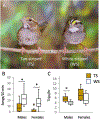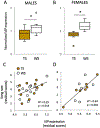Inside the supergene of the bird with four sexes
- PMID: 32937166
- PMCID: PMC7725849
- DOI: 10.1016/j.yhbeh.2020.104850
Inside the supergene of the bird with four sexes
Abstract
The white-throated sparrow (Zonotrichia albicollis) offers unique opportunities to understand the adaptive value of supergenes, particularly their role in alternative phenotypes. In this species, alternative plumage morphs segregate with a nonrecombining segment of chromosome 2, which has been called a 'supergene'. The species mates disassortatively with respect to the supergene; that is, each breeding pair consists of one individual with it and one without it. This species has therefore been called the "bird with four sexes". The supergene segregates with a behavioral phenotype; birds with it are more aggressive and less parental than birds without it. Here, we review our efforts to identify the genes inside the supergene that are responsible for the behavioral polymorphism. The gene ESR1, which encodes estrogen receptor α, differs between the morphs and predicts both territorial and parental behavior. Variation in the regulatory regions of ESR1 causes an imbalance in expression of the two alleles, and the degree to which this imbalance favors the supergene allele predicts territorial singing. In heterozygotes, knockdown of ESR1 causes a phenotypic switch, from more aggressive to less aggressive. We recently showed that another gene important for social behavior, vasoactive intestinal peptide (VIP), is differentially expressed between the morphs and predicts territorial singing. We hypothesize that ESR1 and VIP contribute to behavior in a coordinated way and could represent co-adapted alleles. Because the supergene contains more than 1000 individual genes, this species provides rich possibilities for discovering alleles that work together to mediate life-history trade-offs and maximize the fitness of alternative complex phenotypes.
Keywords: Alternative phenotypes; Coadaptation; Estrogen receptor alpha; Inversion polymorphism; Life-history strategy; Parental behavior; Social behavior; Song; Territorial aggression; Vasoactive intestinal peptide.
Copyright © 2020 Elsevier Inc. All rights reserved.
Figures






Similar articles
-
Allele-specific cis-regulatory methylation of the gene for vasoactive intestinal peptide in white-throated sparrows.Genes Brain Behav. 2022 Nov;21(8):e12831. doi: 10.1111/gbb.12831. Epub 2022 Oct 11. Genes Brain Behav. 2022. PMID: 36220804 Free PMC article.
-
Genes located in a chromosomal inversion are correlated with territorial song in white-throated sparrows.Genes Brain Behav. 2015 Nov;14(8):641-54. doi: 10.1111/gbb.12252. Epub 2015 Oct 14. Genes Brain Behav. 2015. PMID: 26463687 Free PMC article.
-
Vasoactive intestinal peptide as a mediator of the effects of a supergene on social behaviour.Proc Biol Sci. 2020 Apr 8;287(1924):20200196. doi: 10.1098/rspb.2020.0196. Epub 2020 Apr 8. Proc Biol Sci. 2020. PMID: 32259472 Free PMC article.
-
Endocrine and genomic architecture of life history trade-offs in an avian model of social behavior.Gen Comp Endocrinol. 2008 Jul;157(3):275-82. doi: 10.1016/j.ygcen.2008.03.023. Epub 2008 Mar 31. Gen Comp Endocrinol. 2008. PMID: 18495122 Review.
-
Estrogen Receptor Alpha as a Mediator of Life-History Trade-offs.Integr Comp Biol. 2015 Aug;55(2):323-31. doi: 10.1093/icb/icv005. Epub 2015 Apr 7. Integr Comp Biol. 2015. PMID: 25855477 Free PMC article. Review.
Cited by
-
Supergenes are not necessary to explain the maintenance of complex alternative phenotypes.Proc Biol Sci. 2024 Oct;291(2033):20241715. doi: 10.1098/rspb.2024.1715. Epub 2024 Oct 16. Proc Biol Sci. 2024. PMID: 39406344 Free PMC article.
-
Allele-specific cis-regulatory methylation of the gene for vasoactive intestinal peptide in white-throated sparrows.Genes Brain Behav. 2022 Nov;21(8):e12831. doi: 10.1111/gbb.12831. Epub 2022 Oct 11. Genes Brain Behav. 2022. PMID: 36220804 Free PMC article.
-
Genome-wide variation in DNA methylation linked to developmental stage and chromosomal suppression of recombination in white-throated sparrows.Mol Ecol. 2021 Jul;30(14):3453-3467. doi: 10.1111/mec.15793. Epub 2021 Jan 26. Mol Ecol. 2021. PMID: 33421223 Free PMC article.
-
Dynamic molecular evolution of a supergene with suppressed recombination in white-throated sparrows.Elife. 2022 Aug 30;11:e79387. doi: 10.7554/eLife.79387. Elife. 2022. PMID: 36040313 Free PMC article.
-
Chromosome-scale assemblies of the male and female Populus euphratica genomes reveal the molecular basis of sex determination and sexual dimorphism.Commun Biol. 2022 Nov 4;5(1):1186. doi: 10.1038/s42003-022-04145-7. Commun Biol. 2022. PMID: 36333427 Free PMC article.
References
-
- Anderson AR, Hoffmann AA, McKechnie SW, Umina PA, & Weeks AR (2005). The latitudinal cline in the In (3R) Payne inversion polymorphism has shifted in the last 20 years in Australian Drosophila melanogaster populations. Molecular Ecology, 14(3), 851–858. - PubMed
-
- Archer J (2006). Testosterone and human aggression: an evaluation of the challenge hypothesis. Neuroscience & Biobehavioral Reviews, 30(3), 319–345. - PubMed
Publication types
MeSH terms
Grants and funding
LinkOut - more resources
Full Text Sources
Miscellaneous

